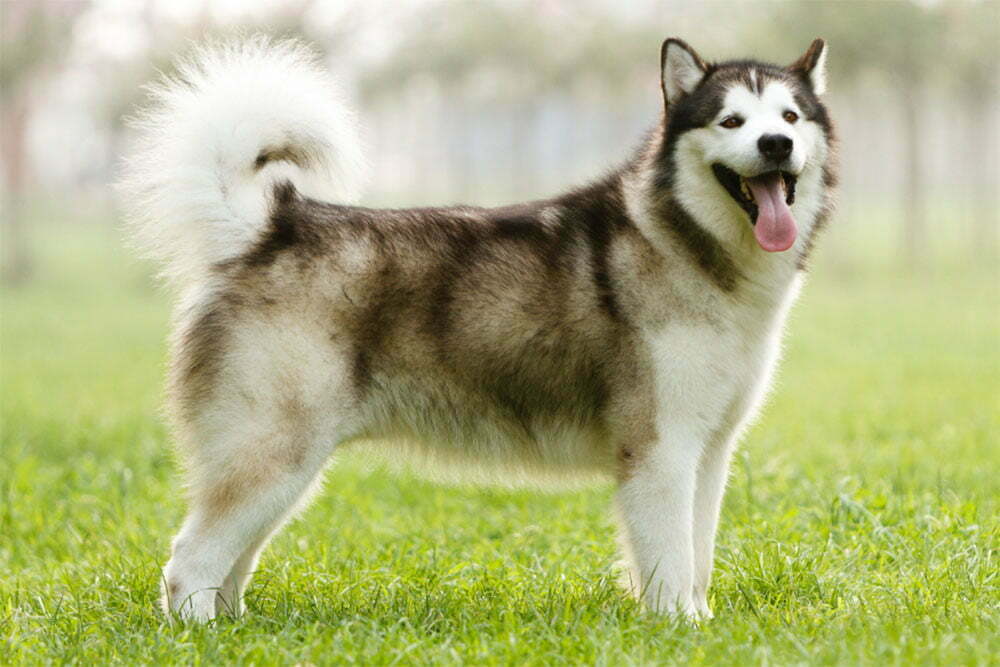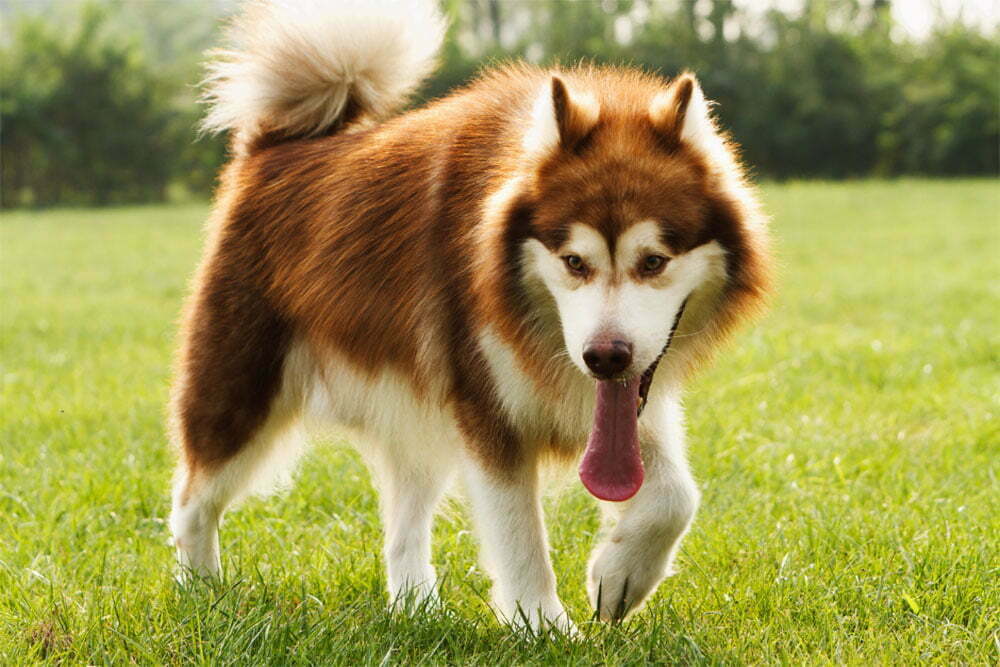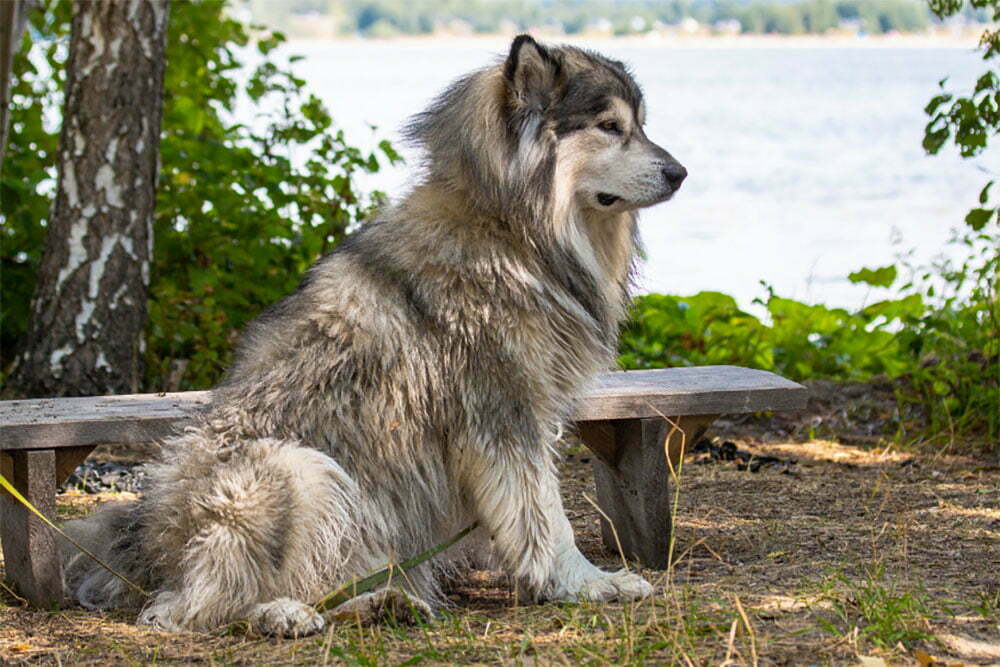The Alaskan Malamute is one of the oldest dog breeds in the world. It was initially used in the Arctic as a sled dog, and is believed to have been descended from gray wolves and wolf dogs who accompanied Paleolithic hunters during ancient times.
This breed is not only strong in build, but strong minded too. The Alaskan Malamute has a lot of specific needs and requirements, which makes them unsuitable for novice dog owners.

These dogs need a lot of exercise, and are very high maintenance. With a thick, double coat, you can expect them to shed all year around.
However, they are fiercely loyal, loving canine companions and very affectionate towards their owners.
Find out if this breed is right for you with our Alaskan Malamute: Ultimate Guide.
What is an Alaskan Malamute: Key Facts
An Alaskan Malamute is a medium to large sized working dog that is known for its ability to pull sleds. As the name suggests, the Alaskan Malamute hails from the icy tundra of Alaska, and was used by natives to pull sleds.
They are generally very large in build, and sturdy in appearance. With wolf life features, this breed can look extremely fierce, but do not be scared, they are big softies. Alaskan Malamutes are very affectionate and loving dogs, who require a lot of attention and companionship to be happy.
The Alaskan Malamute is super intelligent, social and very energetic. They need plenty of exercise to remain mentally and physically stimulated. As Alaskan Malamutes were bred to work by Innuit people, they are very strong dogs, who were able to pull immense loads on a sled.
They do look very similar to Siberian Huskies when it comes to physical appearance and attributes, however, if you put the two breeds side by side, you will quickly see how large the Malamute is, and how much this fluffy gentle giant dwarfs the medium sized husky.
As a result, Malamutes were bred for agility, strength and endurance rather than speed, and were used to pull heavy loads over a long period of time, rather than a short and fast period of time.
Nowadays, Malamutes are bred as pets, and used as family dogs and no longer have to haul heavy loads across Alaska. However, they still have a lot of energy to burn, and will need a lot of exercise, attention and space.
Therefore, you can expect this giant, ancient breed to not only take over your heart, but also your home as well.
- Average lifespan: 12 – 15 years
- Minimum exercise per day: 2 hours
- Coat length: Thick, dense double coat
- Minimum cost per month: $150
Appearance: What does an Alaskan Malamute Look like?
An Alaskan Malamute is a large sized dog, built to work. As a result, this breed has a very strong, sturdy and powerful looking body, giving them enough strength and stamina to withstand the harshest of weather conditions, and able to pull sleds in extreme environments.
Alaskan Malamutes tend to have big heads and bodies, with pointed ears and strong legs. They also have a curved-in tail that is incredibly furry, and carried over the back like a plume.
Some people assume that Alaskan Malamutes have blue eyes much like the Siberian Husky, however this is not strictly true, as purebred Alaskan Malamutes always have brown eyes. If they are mixed with Huskies, then they may have blue eyes, and may not be a Malamute.
As one of the oldest and long-standing dog breeds, its appearance has not changed drastically over the years. The Alaskan Malamute remains today and looks just like its initial ancestors.

In addition, these dogs were believed to have been bred from wolf dogs, and as a result do retain many wolf-like features such as the pointed ears and nose.
Alaskan Malamutes also share their coat colors with gray wolves, appearing in white, black and gray variations. The coat of the Alaskan Malamute is what makes them so identifiable. Alaskan Malamutes have an extremely thick double coat.
The undercoat is oily and woolly in texture, and can grow as thick as two inches. Then, there is the outer coat, which is very coarse and stands longer off the body, at about one-two inches long.
Because of this, Alaskan Malamutes tend to shed heavily two times a year, where the hair can fall out in big clumps. Although, you may notice that this breed loses hair almost all of the time. They require frequent brushing and grooming.
As these dogs have so much energy to burn off, they do require a good, healthy diet, and they will eat a lot. However, they should always have ample exercise to burn this off, and should not be overweight.
Size
Large sized dog
Average height
Males about 25 inches at the shoulder
Females about 23 inches at the shoulder
Average weight
75-100 lbs
Temperament
If you have ever seen an Alaskan Malamute in person, then it is easy to become apprehensive of their immense size, and wolf-like coat and characteristics. However, these dogs are completely domesticated, despite being bred from wolves.
The Alaskan Malamute is an intelligent dog, known for its energy, endurance, strength and independence. They were originally used for sled pulling, but quickly became very loyal and fierce looking canine companions.
They may look like wild animals, but the Alaskan Malamute is typically very soft and friendly in temperament. They have big personalities, and love to meet new people.
They are very outgoing animals, and will greet strangers with attention, kisses and affection. That’s why they do not make such great guard dogs, as they will not be fearful of intruders.
The Alaskan Malamute is a very friendly and playful creature, and can be really outgoing.
This is what so many people love about the Alaskan Malamute, they are just like big cuddly teddy bears. They love greeting people, and can become fiercely loyal towards their family members and friends.
Being descended from wolves, Alaskan Malamutes are pack animals, and therefore always want to be with the pack, meaning their human companions.
They have to be included in everything you do, as this is how they would behave in a pack. Wolf packs hunt, eat, sleep, play and travel together. Be prepared to have a Malamute as your shadow, following your every move.
They are not prone to barking much, although they will enjoy howling and talking to you. The Malamute tends to make woo woo sounds, and will enjoy the sound of its own voice.
Despite being very friendly creatures, their temperament depends on how well they are trained, and whether they get enough early socialization and exercise. Without this, they can become bored, destructive, disobedient and aggressive.
Apartment living
Not suitable for apartment living
Good for novice owners
Not a suitable pet for a first time owner. Alaskan Malamutes need a lot of special care and attention. They also have a high energy drive, and can become aggressive if their needs are not met.
Sensitivity level
Can be rather sensitive dogs, and will need an assertive owner
Tolerate being alone
Does not tolerate being alone, and can be prone to separation anxiety and destructive behaviors when left alone
Tolerate cold weather
Loves the cold weather, and is bred for extreme weather conditions
Tolerate hot weather
Can shed its coat to deal with summer months, but is not great in hot weather due to its dense, thick coat
Affectionate with family
Very affectionate with their family
Kid friendly
Moderately kid friendly. Will need to be introduced to children from a young age so that it can grow used to them, and understand how to behave around them
Dog friendly
Moderately dog friendly. Most are playful, but some can be fearful or aggressive towards other dogs
Friendly towards strangers
Very friendly and interested in new people and strangers. Will greet guests with a wagging tail. Not the recommended dog breed for guarding the home or warding off intruders.
Health And Grooming
Alaskan Malamutes are generally very healthy dogs. They live for about 10-15 years, and are not very prone to lots of diseases.
However, there are some that can be more prone to health conditions than others. As many large dog breeds are, Alaskan Malamutes are prone to hip dysplasia in the latter years of their lives.
Hip dysplasia is a heritable condition where the thigh bone rubs against the hip joint, causing a lot of pain, inflammation and irritation.

As the condition worsens, pain can be more extreme, and dogs can become lame. This often develops as the dog ages, but can be managed with medication. They can also be prone to elbow dysplasia.
One of the most common health issues Alaskan Malamutes are prone to is hypothyroidism. This is when the dog produces a low amount of thyroid hormones, which can lead to a dry, sparse coat, loss of hair, eye discharge, pale mucous membranes and other issues.
However, this can also be managed with medication such as a thyroid supplement pill daily.
When it comes to shedding, expect a Malamute to shed a lot. They have a dense double coat, that is around two inches deep. However, the coat should not be soft or long, it is woolly and oily. That being said, Malamutes are clean dogs, and their coats are odorless.
Shedding
Yes. Alaskan Malamutes are very prone to shedding as they have a thick, double coat. Whilst this should only happen twice a year, you may find that your house is constantly covered in fur.
Grooming
Due to their immense coat, Alaskan Malamutes need frequent grooming, which can be costly and difficult to maintain. They also get dirty very easily and need bathing. You should groom a Malamute 1-3 times a week.
Drooling
Not prone to drooling, but need teeth brushing daily
General health
Alaskan Malamutes have good general health but can be prone to some health problems.
Health problems
Most Alaskan Malamutes are healthy, and have a lifespan of about 12 years, but can be prone to conditions such as hip dysplasia, bloating and hypothyroidism.
Potential for weight gain
Moderate
Trainability
As lovely as they are, the Alaskan Malamute has an immense amount of energy. Without ample exercise, mental and physical stimulation, the Malamute is known to become destructive, restless or even aggressive.
They are very independent creatures, and very strong willed. Without proper training and guidance, an Alaskan Malamute will try to rule over you and be the Alpha.
Just like a wolf pack, Malamutes will want to challenge you to become the top dog, shall we say. They will want to rule over you, and will try to establish a pecking order.
It is vital that you beat them to it, and make sure that you or any other family members are not being pushed around.
This behavioral trait can give them the reputation of being naughty, stubborn or unwilling to learn. However, it does depend on the owner, as Alaskan Malamutes need a very assertive and experienced handler.
This is why this breed is not recommended for first time dog owners, and is unsuitable for apartment living. They need a lot of space to wander, explore, and love to be in the backyard.
These dogs are very prone to digging, as they love to dig up a large hole in the ground to sit in and stay cool in. This is how its ancestors would have survived the cold weather, and the instinct to dig holes has been passed onto the Malamute.
In addition to this, Malamutes can be fearful or aggressive towards other animals and dogs in particular. They require early socialization and training, so that they know from a young age how to get along with other dogs, pets and animals.
They also have a very high prey drive, which means that they love to stalk and kill small animals that get in their way. This includes birds, squirrels, cats and even sometimes small dogs.
Whilst chasing cats and squirrels can be part of their natural instincts, you should not encourage this as they may become aggressive with other dogs.
Easy to train
Moderately easy to train
Intelligence
Rather intelligent dog breed
Potential to bite
Moderate. Can be destructive and aggressive without training or stimulation
Tendency to bark or howl
Very high tendency to bark or howl
History Of Breed
The Alaskan Malamute is one of the oldest dog breeds in the world, and is largely regarded as the oldest Arctic sled dog. An Innuit tribe, known as the Mahlemuts settled in the northeastern area of Seward Peninsula in Alaska which is where this dog was first developed and bred.
They were originally used to hunt seals, chase away polar bears and help their companions pull heavy sleds loaded with supplies, food and exports.
However, the Innuit people loved and cared for their sled dogs deeply, and they quickly became attached to one another, which is why the Malamute is so loving, loyal and friendly.
During the Gold Rush in 1896, more and more dogs were brought to Alaska to help pull sleds and move exports. These dogs were bred to survive the harsh winters, and be large and strong enough to work in such conditions.
These dog breeds were interbred a lot, but the Mahlelmut tribe was very isolated, and so their Alaskan Malamutes remained pure.
There was a dog driver and Gold Rush adventurer who bred dogs called Arthur T. Walden. He established a Chinook Kennel in New Hampshire, and started to breed Alaskan Malamutes too.
His successors, the Seeley brothers also began breeding and supplying dogs for Antarctic expeditions during the 1930s. This new strain of Alaskan Malamutes was known as the Kotzebue strain of dogs.
This line of Malamutes was slightly different from a strain bred by Paul Voleker, Sr. which was called the M’Loot strain during the 1900s and 1920s. These dogs were often used in expeditions and in World War II, and largely died out.
In 1935, the American Kennel Club began to recognize the breed, and registered it in the same year.
Today, all American Kennel Club registered Alaskan Malamutes are traced back to the Kotzebue strain, and have hardly varied from the first initial Alaskan Malamutes bred by the Innuits.
Costs
On average, an Alaskan Malamute puppy can cost anywhere between $500 and about $3000, depending on whether the breeder is experienced, registered and established or not, and the lineage of the dog itself.
The average price of an Alaskan Malamute is about $900, with the first year expenses costing around $4,200 to purchase things like a crate, grooming equipment, food and toys.
We weren’t kidding when we said an Alaskan Malamute is high maintenance, as these dogs cost about $154 a month, or $1850 a year to keep.
They need regular grooming and checkups, and eat a lot of food a day, so be aware of this before considering one. That’s a lot of money a year considering they can live for up to 15 years!
Fun Facts
Have you ever wondered why they are called Malamutes? We know why they are called Alaskan, as that’s obvious, but what you may not have realized is that this breed was named after the Innuit tribe called Mahlemuts, who once settled along with shoes of the northwestern parts of Alaska.
Alaskan Malamutes are often confused with the Siberian Husky, due to their similar appearance, bright eyes and fluffy coats. However, they are different breeds.
That being said, the Malamute is native to Alaska, whereas the Husky is native to Siberia, yet they are distantly related cousins. They are also considered to be related to the Eskimo dogs of Greenland, along with the Samoyed dogs of Russia!
Did you know that Alaskan Malamutes are very vocal animals. Whilst they do not like to bark much, they will howl and whine. Some owners even encourage this behavior as it can seem as if the dog is speaking. They will respond to similar noises such as ambulance sirens and try to replicate them.
